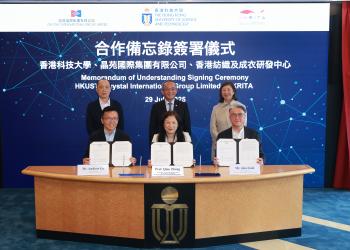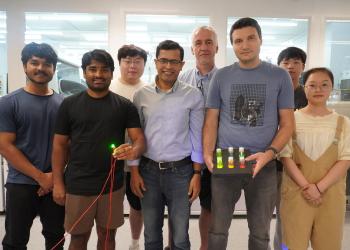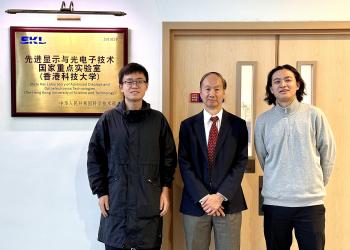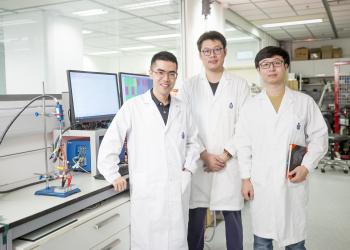News & Stories
2025

News
HKUST, Crystal Group, and HKRITA Signed Framework Agreement
The Hong Kong University of Science and Technology (HKUST) has signed a tripartite framework agreement with global apparel manufacturer Crystal International Group Limited (Crystal Group) and the Hong Kong Research Institute of Textiles and Apparel (HKRITA) to integrate advanced artificial intelligence (AI) throughout the textile production process. By developing industry-specific large language model Textile-GPT for textiles, the collaboration aims to enhance intelligent design, optimize production process, streamline supply chain management, automate quality inspections, and foster innovation in smart wearables.

News
HKUST’s Next-Gen QRLEDs Transform Smartphone & TVs with Ultra-Bright and Color-Rich Displays
Researchers at the Hong Kong University of Science and Technology (HKUST) School of Engineering have cracked a major challenge in display technology by inventing the world’s brightest and most energy efficient quantum rod LEDs (QRLEDs). These next-generation QRLEDs feature optimized deep green emission at the top of the color triangle, enabling displays with unprecedented color purity and a maximized color gamut. Boasting a longer lifespan and triple the brightness of previous models, these cutting-edge light sources deliver energy-efficient, ultra-vivid visuals for smartphones, televisions, and AR/VR devices while further enhancing color performance.
News
Seven HKUST Projects Secure Funding in RAISe+ Second Round
The Hong Kong University of Science and Technology (HKUST) has shone in the second round of Research, Academic and Industry Sectors One-plus (RAISe+) Scheme launched by Innovation and Technology Commission’s (ITC), securing grants for seven teams – the highest number among local institutions.
The seven funded projects encompass a diverse array of innovative research and development efforts. Three projects focus on health and medical innovation, addressing areas spanning diagnostics, medical treatment and gene therapy. Three others focus on AI chips, semiconductors and their materials, while the remaining one explores novel displays and optoelectronic technology.

News
HKUST Leads Local Institutions in RAISe+ Scheme with 7 Funded Projects
The Hong Kong University of Science and Technology (HKUST) has emerged as the top-performing local institution in the second round of the Innovation and Technology Commission’s (ITC) Research, Academic and Industry Sectors One-plus (RAISe+) Scheme, securing funding for seven projects. Spanning health and medical sciences, artificial intelligence (AI) and robotics, advanced manufacturing, and electrical and electronic engineering, these projects underscore HKUST’s leadership in transforming pioneering research into real-world applications.
2024

News
HKUST Engineering Researchers Develop World’s First Deep-UV MicroLED Display Chips for Maskless Photolithography
In a breakthrough set to revolutionize the semiconductor industry, the School of Engineering of the Hong Kong University of Science and Technology (HKUST) has developed the world’s first-of-its-kind deep-ultraviolet (UVC) microLED display array for lithography machines. This enhanced efficiency UVC microLED has showcased the viability of a lowered cost maskless photolithography through the provision of adequate light output power density, enabling exposure of photoresist films in a shorter time. Conducted under the supervision of Prof. KWOK Hoi-Sing, Founding Director of the State Key Laboratory of Advanced Displays and Optoelectronics Technologies at HKUST, the study was a collaborative effort with the Southern University of Science and Technology, and the Suzhou Institute of Nanotechnology of the Chinese Academy of Sciences.
2022

News
HKUST Researchers Develop Nanoporous Zinc Electrodes that Make Primary Alkaline Zinc Batteries Rechargeable
A research team at The Hong Kong University of Science and Technology (HKUST) has developed a new electrode design that is set to enable the rechargeability of alkaline zinc batteries, one of the most common types of non-rechargeable batteries used in our daily lives, shedding light on a wider application of rechargeable batteries.
Batteries are ever important in the age of smart cities and global digitalization. Yet, a majority of batteries in the market are not rechargeable, or called primary batteries. They are disposed after a single use, an unsustainable practice that poses a serious threat to the environment.
2021

News
Active Liquid Crystal Systems Examined in Search of Autonomous Materials Systems
Liquid Crystals (LC) are widely deployed in display technology and optical fibres. From smartphones in your pockets to large screen TVs, LCs are everywhere, as this special state of matter has been found in colorful soap bubbles as well as certain living tissues.
2020
News
Deep-brain Imaging at Synaptic Resolution Made Possible with Adaptive Optics Two-photon Endomicroscopy
The ability to undertake in vivo imaging of a living brain in a mammalian animal model is crucial for elucidating how the brain functions. However, the brain consists of tens of billions of neurons, each connected with thousands of others via synapses, the sites of communication between neurons that allows transmission of information. Thus, to truly understand the dynamics of neuronal synaptic interactions, the capacity for morphological and functional imaging of the brain at high spatial and temporal resolution is required.






